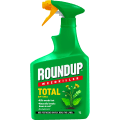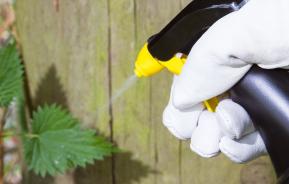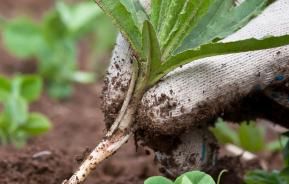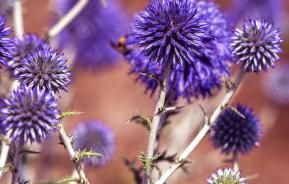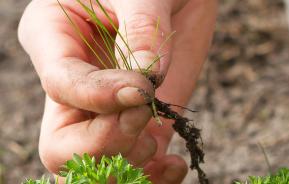Common garden weeds are persistent garden invaders that will often grow back if you fail to treat them correctly. Before you are able to effectively treat/remove them you must first be able to identify whether or not it is a garden weed.
Weeds can be divided into 3 groups which can help determine the best way to identify them:
- Annual weeds
- Lawn weeds
- Perennial and woody weeds
If you need to find out more information on the best treatments for killing or controlling garden weeds we recently wrote about how to kill and stop weeds growing back.
Annual weeds
Annual weeds are the ones that last for one year or growing season only but which produce lots of weed seeds for next year and years afterwards.
Use our simple guide to help identify your weed and help you find the ideal product to tackle the job in hand. Our range has been specially formulated to provide effective ways to control garden weeds without the hard work!
1. Fat hen (Chenopodium album)
The Fat Hen weed is the fastest growing of all of the annual weeds. There are many different varieties. It is possible for a Chenopodium album to produce 20,000 seeds in its lifetime just from one single plant. In its baby form the Fat Hen can be used in salads as it is very tasty but must be monitored carefully in order to prevent the growth across open ground.
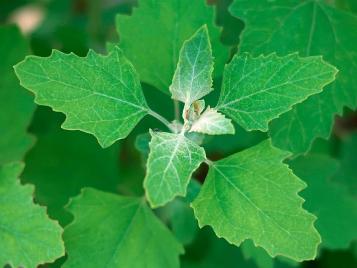
How to identify? Young fat hen weeds have bright green leaves which tend to darken with age and look similar to the image above. The Chenopodium album will grow between 2 and 4 feet tall with a vertical stem. This can be difficult to identify for beginners as it can appear in many intermediate forms but the colour and shape of the leaves are the main identifying trait. The lower leaves are usually shaped like a rhomboid whereas the upper leaves would usually appear as a branched stem.
2. Chickweed (Stellaria media)
Chickweed is one of the most common in the UK. It varies greatly in size and weight and can be found in a multitude of locations including your garden. Like Fat Hen the Chickweed’s baby form is very tasty and makes a great addition to a salad as well as being loaded with vitamins & minerals. You are advised to disperse of this weed as soon as possible as it attracts Spider Mite and Greenfly which will ruin any edibles you are growing.
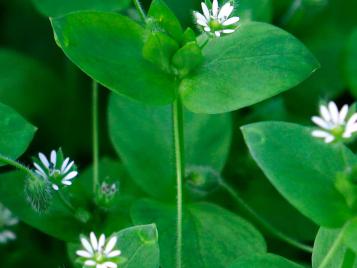
How to identify? Chickweed is most easily identified by its small white star shaped flowers and tiny white line of weaved hair that grows along the stem. You can expect the Stellaria media to vary in size between 5cm and 50cm with oval shaped leaves that have pointed tips. The texture of the leaves can vary from smooth to slightly hairy.
3. Groundsel (Senecio vulgaris)
This weed is capable of being blown in by wind from surrounding areas such as fields or neighbouring gardens so don’t be surprised if it crops up at random. Like most common weeds Groundsel can produce a large amount of seeds to the extent that it can produce numerous generations of weed within one growing season.
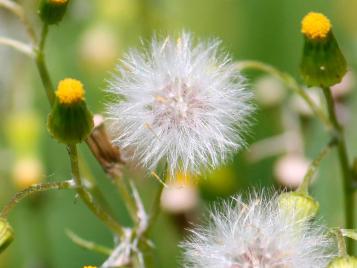
How to identify? A groundsel weed is capable of growing up to 2 feet tall with a variety a leaf ranging from lightly hairy with cotton-like hairs to smooth. The stems branch out into little clusters which have small yellow flower heads. The leaves of the Senico vulgaris are evenly spaced on the stem and have toothed edges.
Lawn weeds
The plants that can grow so vigorously they simply ‘suffocate’ the grass.
Use our simple guide to help identify your weed and help you find the ideal product to tackle the job in hand. Our lawn weedkiller range has been specially formulated to provide effective weed control without the hard work!
1. Plantain (Plantogo major)
Plantain weeds are extremely common garden weeds and are found almost everywhere in the UK. It regrows particularly fast in Spring when the lawn has been mowed and you will see an abundance of new shoots appearing.
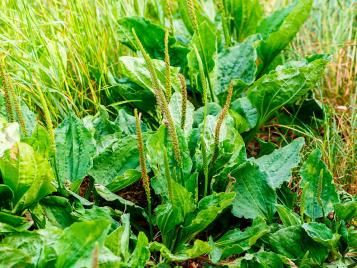
How to identify? The greater plantain weed is very easy to identify as it is quite consistent in its appearance. It appears as a flat rosette of leaves that are a broad oval shape with distinctive ribs.
2. Dandelion (Taraxacum officinale)
A little known fact about the Dandelion is that is one of the healthiest vegetables around. Taraxacum officinale have an abundance of vitamin A, C and K stored in their leaves as well as a healthy dose of calcium, potassium and iron.
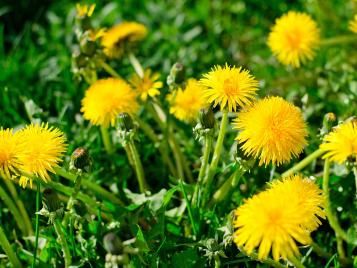
How to identify? Like the plantain the dandelion forms a large rosette, except it has a long stout tap root. The Taraxacum officinale is easily recognisable with a distinct yellow flower that possesses lance shaped leaves. You will also notice a white fluffy looking ‘flower’ on a dandelion which contains the seedlings that are distributed by the wind as they are easily detached.
3. Daisy (Bellis perennis)
This is likely the most common and recognisable lawn weed in the UK. We are sure many of us have had a go at making a daisy chain at least once in our lives. Daisies have the ability to grow in a wide range of soil conditions and locations. Bellis perennis weeds also have the ability to out-compete other weeds by spreading and forming mats of foliage, causing them to die.

How to identify? If by any chance you are not already familiar with a daisy, it is a small white flowered weed with a yellow centre. There is a small rosette at the base which the flower sprouted from.
Perennial weeds and woody weeds
Perennial or woody weeds are the weeds that produce large deep or creeping roots that keep coming back year after year. They can grow again from even the smallest segment so digging them up often makes the problem worse.
Use our simple guide to help identify your weed and help you find the ideal product to tackle the job in hand. Our tough weedkiller range has been specially formulated to provide effective ways to control weeds without the hard work!
1. Broad leafed dock (Rumex obtusifolius)
The broad leafed dock is a highly variable species and can sometimes be difficult to identify as a result. The Rumex obtusifolius is able to grow in a wide range of soils although the seedlings are poor competitors and can only grow effectively in open or disturbed patches.

How to identify? Broad leafed dock weeds are fairly easy to identify as they have large oval shaped leaves. During blooming months between May and October the Rumex obtusifolius can produce small green/ white flowers which will turn brown once they are pollinated.
2. Couch grass (Triticum repens, Elymus repens)
Couch grass weeds can grow up to 2 metres tall within one season. Triticum repens is one of the most common perennial weeds in the UK because it flourishes in any type of soil.
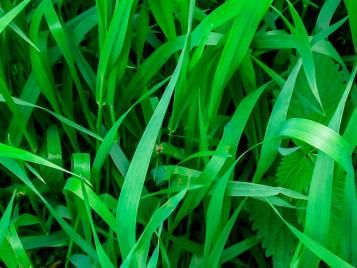
How to identify? This perennial is very easy to identify as it is a one that is very consistent in nature. It appears as a tougher, thicker and longer version of grass and it grows as spiky shoots, in more varied directions than regular grass.
3. Ground elder (Aegopodium podagraria)
The ground elder weed is a rapid spreading plant that can be extremely difficult to prevent. During the Winter season the Aegopodium podagraria will die down into the soil making it very hard to cultivate. This is made worse by the ground elder’s ability to re-grow with only a tiny fragment of root remaining, so you have to be thorough when removing.
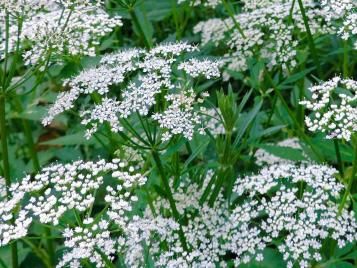
How to identify? In the summer you can easily identify this weed by the white flowers like the ones demonstrated in the image above. Earlier in the year it can be recognised by shoots of dark green leaves coming out of the soil and as conditions improve they will become taller stalks that support the flower.
4. Hedge bindweed (Calystegia sepium)
Hedge bindweed has similar characteristics to a vine in the way that it twists and turns around other plants, fences and objects. It is often found in riverbanks woodlands and ditches and it is one of the more scenic weeds in these locations.
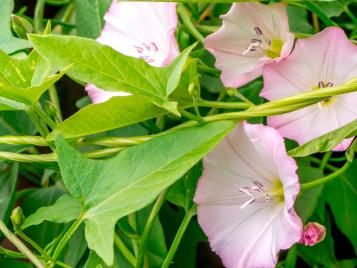
How to identify? The Calystegia sepium can be identified by the white funnel/trumpet end shaped flowers growing from the stem. Bear in mind that the flowers are usually only bloomed between June and September.
5. Japanese knotweed (Fallopia japonica)
Japanese knotweed is a strong growing and rapid spreading weed that is very widespread in the UK. It has previously attracted a lot of media attention for ‘taking over Britain’ which is an indicator of just how common it is. Similar to Ground Elder, this weed will die back in the winter to make it extremely difficult to remove. There is legislation around controlling or managing knotweed so do research what you need to do to resolve this weed.
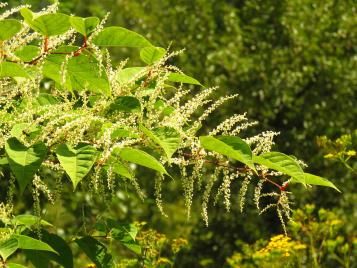
How to identify? Japanese Knotweed can be identified early by little red tinged shoots appearing. Once it starts to grow it will develop a hollow bamboo like stem up to over 2 metres tall with large spade shaped leaves up to 14cm in length and clusters of creamy white flowers.
6. Nettle (Urtica dioica)
Commonly known as the ‘stinging nettle’ Urtica dioica is a herbaceous perennial weed. Chemicals in the leaf trichomes of some nettle species produce a stinging sensation on skin contact.
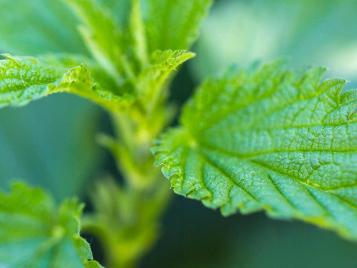
How to identify? Nettles are fairly obvious to identify with some very distinctive features. The nettle weed has green oval shaped leaves with teeth lining the edge. The Urtica dioica has a square stem with tiny hairs, and can grow up to 2 metres tall. Failing that, if you are brave you can always identify it by touching the teeth!

